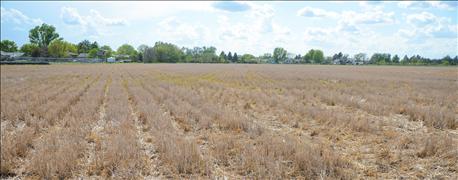
This year, year, the Panhandle No-Till Partnership kicked off a demonstration project near Alliance to compare two plots: 20 acres in a rotation of corn, field peas and wheat adjacent to 10 acres in a rotation of wheat and summer fallow. This includes working with the local Natural Resources Conservation Service to conduct soil tests for infiltration, examining bulk density and organic matter to help quantify the benefits of breaking the fallow period in the rotation with field peas.

NO-TILL PLOT: The goal of two plots near Alliance is to compare 20 acres in a rotation of corn, field peas and wheat (pictured here) with 10 acres rotated in wheat and summer fallow. The goal is to show that having something growing every year, rather than leaving acres fallow, is manageable in the Panhandle’s semi-arid climate.
The Panhandle No-till Partnership is a joint effort between NRCS, Panhandle Resource Conservation and Development Inc., and the North Platte Natural Resources District, South Platte NRD and Upper Niobrara White NRD to provide educational support, knowledge and practical-use techniques for continuous no-till practices.
"The goal [of the plots] essentially is to show the difference between soil organic matter and how it can be increased by incorporating a living root every year," says Robin Foulk, NRCS district conservationist at the Upper Niobrara White NRD. "What we're trying to show is that growing something, instead of leaving acres fallow, is doable in our dry climate. The end result would be increased organic matter, and you're building the soil by cutting out that fallow period and having a living plant growing."
Mark Watson, no-till education coordinator with the Panhandle No-Till Partnership, explains Jim and Jacci Irwin, the farming couple who own the plot, got the idea from a trip up to Burleigh County Soil Conservation District's Menoken Farm demonstration site. The farm, located near Bismarck, N.D., is using a combination of cover crops and companion crops to keep living roots growing in the soil throughout the growing season, as well as incorporating livestock grazing and pollinators to optimize organic matter and infiltration, and realize the full benefits of cover crops.
"Jim and Jacci came back here and saw these summer fallow acres and wondered what we were doing wrong," Watson says. "They asked what do you think if we used 20 acres to do something similar?"
Watson, who has been no-tilling and growing field peas since the late 1980s, hopes to one day incorporate forage crops, livestock and pollinators into the demonstration plot. Citing renowned no-till advocate and research manager at the Dakota Lakes Research Farm in Pierre, S.D., Watson notes the important thing is starting on the soil health highway.
"It doesn't have to be all in. because you can go broke trying to improve soil health. If you look around Box Butte County, you don't see near the bare ground you used to," Watson says. "We're making a difference. You're seeing growers starting to do things we did 20 years ago, but at least they're getting on that highway."
About the Author(s)
You May Also Like






